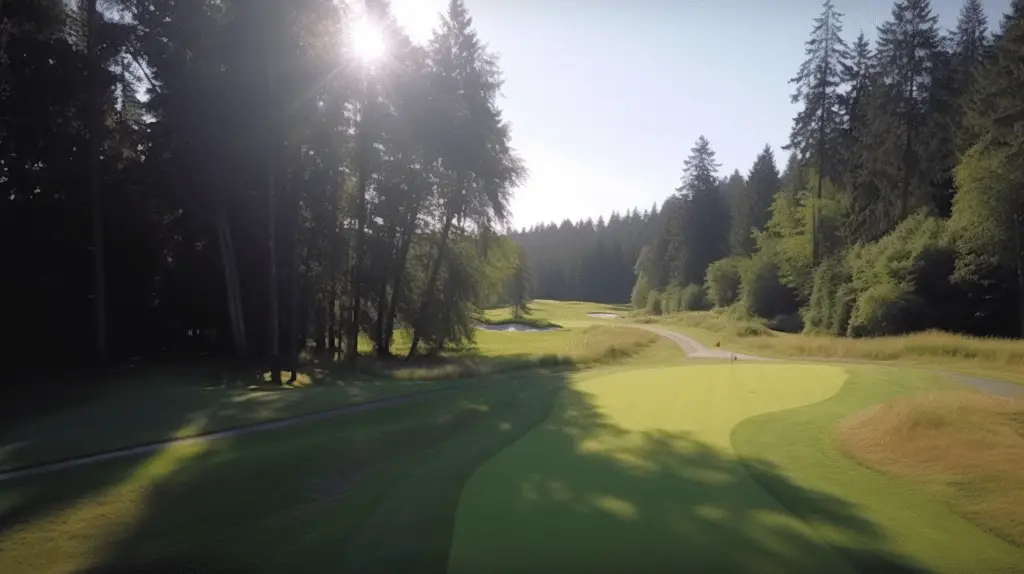Last Updated on June 12, 2023
Golf is a beloved sport for many people around the world. It’s easy to understand why – participating in golf can be incredibly relaxing. It’s great exercise and offers lots of opportunities for socializing. But what do you actually find on a golf course? Let’s explore everything from the driving range to the putting green that makes up every golfer’s playground.
Structure Of A Golf Course
A typical golf course layout consists of 18 holes and is arranged in a loop. Each hole has its own unique structure, which includes a teeing ground, fairway, roughs, hazards and the putting green with its flagstick and cup. The design of each hole will vary depending on the terrain; some may feature hills or water hazards that require special attention from the golfer.
Course designers take into account various factors while designing each hole, such as wind direction, slope and drainage. In order to create a challenging yet enjoyable round for all levels of play, they strategically place bunkers and other obstacles at certain points throughout the course. A smooth playing surface is also important for ball control and consistent shot-making – many courses are mowed daily and have their greens regularly rolled to ensure optimal conditions for players. That way, everyone can enjoy their game without having to worry about any unexpected difficulties.
Fairways And Roughs

A golf course typically consists of two main areas: fairways and roughs. Fairways are the manicured grassy areas that run along the length of each hole, while roughs are made up of longer, thicker grass that lines the edges of each hole.
Fairway grass is usually cut shorter than rough grass to allow for a smoother ride when playing golf shots from this area. The shorter grass provides more consistent contact with the clubface, which helps keep balls on track towards the target. Golfers generally favour hitting their tee shots into these sections as they offer better control over ball flight and distance.
Roughs provide an extra challenge during play as it takes more effort to hit a shot out of them due to the thick grass lying in between your club and the ball. Additionally, any slight mis-hits will be punished more severely here than on fairways, where the tightness of the turf can help you keep your ball within bounds. As such, avoiding the rough should be a top priority for all players looking to score well!
Hazards And Sand Traps
Golf hazards come in many forms and can be found on almost every golf course. Hazards are usually designed to challenge the golfer’s ability to manoeuvre around them while still making a good shot. Common golf hazards include ponds, streams, bunkers, and rough terrain.
Sand traps or bunkers are perhaps one of the most common golf hazards encountered by players. These sandy pits can make it difficult for even experienced players to hit out of as they require precise contact from the club head onto the ball in order to get it back into play. In addition, sand traps often contain deep ridges that prevent balls from rolling out easily after being struck by a club head. As such, mastering shots out of a bunker is essential for any serious golfer who wants to improve their scores and lower their handicap.
Greens And Pins
The heart of any golf course is the putting greens. Every green has a unique design that challenges even the most experienced golfer. A greenskeeper takes good care of each green and ensures that it’s in top condition. They mow, rake and water the grass to ensure they are always smooth and level for players to have an enjoyable experience.
On each putting green you’ll find pin flags indicating where the hole is located. The flag will also tell you how far away from the tee box your ball needs to be before you can take your next shot. It’s important for golfers to know when their turn comes up so they don’t hit another player’s ball or get too close to them while taking a swing. As such, pin flags provide an essential service on every golf course.
To sum up, greenskeepers are responsible for keeping putting greens in pristine condition so players can enjoy their round of golf with ease. Additionally, pin flags serve as markers between holes, allowing golfers to stay aware of other players’ locations at all times.
Tee Boxes And Bunkers
Moving on from greens and pins, tee boxes and bunkers are other essential features of a golf course. Tee boxes are the starting points for each hole, where golfers place their tees and hit their first shots. The tee box is typically made of either grass or mats, with markers to indicate distances between the golfer’s ball and the pin. Bunkers are also found on most courses; they consist of sand traps that can be hazardous obstacles if not navigated properly. Golf balls may become stuck in the bunker due to poor driving accuracy or too much backspin. To get out of these situations, golfers must use special techniques which require skilful execution. Additionally, it is important for players to plan ahead when entering a bunker, as some have various angles that need to be taken into account before swinging away. All in all, a well-played round of golf will involve navigating around both tee boxes and bunkers in order to achieve success on any given hole.
Water Features
A golf course typically features a variety of water hazards and water features. Water hazards are generally ponds, streams, or lakes which obstruct the path of play for players. These water hazards often have sand bunkers built near them as well to make negotiating them more difficult during gameplay.
Water courses can be found on some golf courses, too; these provide an added challenge because they involve carrying shots over fast-flowing bodies of water such as creeks or rivers. Some courses also feature fountains, cascades, and other decorative elements designed to add beauty to the landscape while providing an aesthetically pleasing view from tee boxes and fairways.
Pathways And Cart Paths
Pathways and cart paths are crucial aspects of any golf course. These pathways allow golfers to navigate the terrain easily while they play, as well as provide access for carts transporting players or their gear.
The design, construction and maintenance of these pathways are important in ensuring that the entire course remains playable and enjoyable. Here’s how:
- Paths must be wide enough to accommodate two-way traffic;
- They should have the proper drainage system so no water accumulates on them;
- The materials used for constructing the paths should be durable, withstanding wear and tear from frequent use;
- All pathways must be clearly marked, making navigation easier.
Clubhouse And Practice Facilities
Moving from pathways and cart paths to Clubhouse and Practice Facilities, golfers are sure to find a variety of places for their practice round or event. Many courses will have a driving range with several targets at various distances, as well as chipping areas with sand bunkers and putting greens. The pro shop is where golfers can purchase balls, tees, apparel, equipment, snacks and drinks, among other items.
The clubhouse also serves as a great resource for food/beverages after a long day outdoors along with being able to view leaderboards and results posted here as well. In addition, it’s always nice to have somewhere comfortable indoors should the weather force the cancellation of play due to inclement conditions outside. Through these resources provided within each facility found on a golf course, players are certainly set up for success both mentally and physically throughout their game experience!
Conclusion
I’m sure that after reading all this information about golfing, you’re now eager to get out and hit the links. With a little bit of preparation and knowledge of proper etiquette, your experience on the course will most certainly be enjoyable.
Before heading out to play, make sure you have all the necessary accessories: comfortable clothing suitable for the weather; clubs; balls; tees; and some snacks. Don’t forget to book a tee time in advance so you can avoid waiting around or being denied access.
Finally, remember that although playing golf is costly, it’s also an incredibly rewarding sport with lots of potential for learning and personal growth. So don’t wait any longer – grab some friends and head out to the nearest golf course! You won’t regret it!



